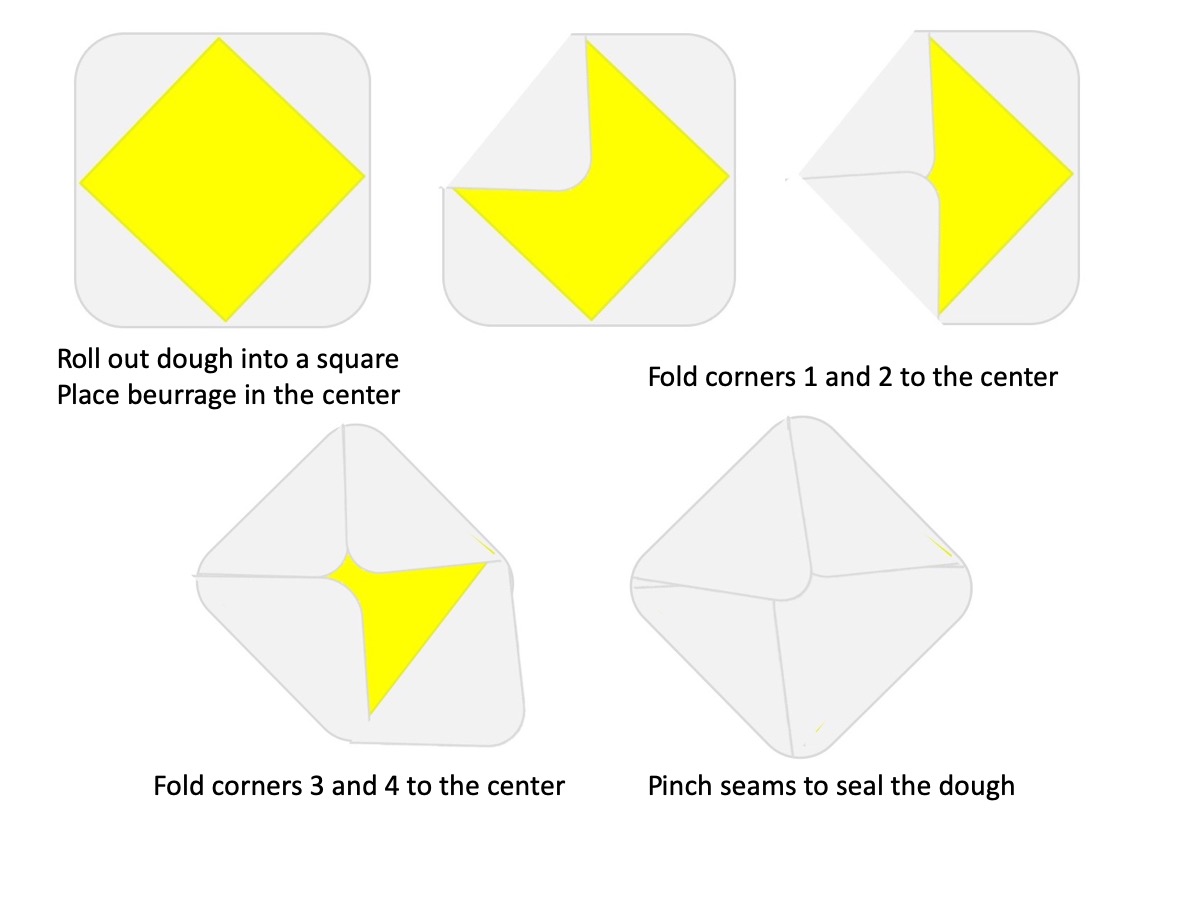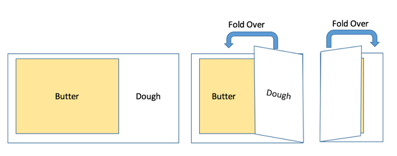Laminated Dough
A laminated dough is made by rolling and folding butter or other fats, known as the beurrage, into the dough to create hundreds of thin layers of flaky pastry. Croissant and Danish pastries, typically served for breakfast, are examples of laminated yeast doughs, while puff pastry, also known as pâte feuilletée or mille feuille (meaning one thousand layers), is an unleavened type. During the baking process, the fats melt and gives off steam which puffs and separates the layers creating a buttery and flaky pastry. Croissants, a rolled, crescent-shaped pastry, also includes filled variations like pain au chocolat (chocolate), and amadine (almond). Savory versions are prepared with cheeses, spinach, or ham. There are three basic steps to a laminated dough that include preparing the dough, enclosing it in butter or other fat, and rolling and folding the dough. Temperature is an important factor in this preparation because the fat must not be too warm (soft) or too cold (firm).
Croissant Dough Ratio
Puff Pastry Dough Ratio
Laminated doughs are enriched with the addition of milk, and in the case of a Danish dough the addition of eggs. These doughs are soft and sticky when mixed. The ratio of liquids is higher at a 2 to 1 ratio of flour to liquid.
Preparing the Dough
The base dough, known as the detrempe, varies depending on the type of pastry. For example, puff pastry dough is made up of flour, water, and salt; croissant dough is prepared with flour, sugar, yeast, salt, and milk; while Danish dough includes the same ingredients as a croissant dough but adds eggs to the mix. An all-purpose flour can be used or a bread flour blended with a soft cake flour. The dough is mixed together until it becomes a sticky mass. Avoid over-mixing so the gluten doesn’t develop too fast or too soon.
Fermenting
Turn the dough out onto a sheet pan and shape into a rectangle. Store on a pan and allow it to ferment. The dough is often chilled from 12-24 hours before it is rolled out.
Rolling the Dough – Locking in the Fat
The dough is rolled and shaped into a rectangle about three times as long as wide to a thickness of about ½ inch/12 mm. Sprinkle lightly with flour as needed and brush off excess once the desired size has been achieved. Butter is the preferred fat for making croissant and Danish, but lard, margarine, and shortening are sometimes used for cost purposes. The temperature of the fat should be approximately 55°F/13°C. The fat is rolled between parchment into a thin rectangular shape that measures approximately ½ - 2/3 of the the desired size of the dough, depending on the desired fold.
Rolling and Folding the Dough
A professional dough sheeter is used for large scale production of laminated doughs. Smaller scale production is done by hand. The butter is placed on the dough and the dough is then folded to lock in the butter using either an envelope fold, single-, letter-, or book-fold.
An envelope-fold places the butter diagonally on top of the dough rolled out to a square. Each corner of the dough is brought to the center locking the butter inside the dough.
Envelope Fold
A single-fold places the butter on one-half of the dough shaped in a rectangle and folds the other half of the dough over the butter.
Single-Fold
A letter-fold or triple-fold lays the butter towards one side of the dough, and the dough is folded in thirds, much like a letter is folded to fit into an envelope.
Letter-Fold or Triple-Fold
For a book-fold the butter is placed in the center of the dough and the edges are folded inward to meet at the center, then folded again at the center line, as if closing a thick book. Croissants typically use a letter-folded, while Danish use a book fold.
Once the butter is folded in, place it on a parchment-lined baking sheet, dust lightly with flour, wrap with plastic wrap, and chilled for approximately 30-45 minutes. It’s important to monitor the temperature of the butter, because if it gets too cold, it affects the lamination process. Ideally the temperature of the butter should be 55°F/13°C.
Turning and Rolling the Dough
Turn the dough 90° and roll out in a rectangle to a rectangle, keeping the edges straight and the corners square. Fold the dough into a letter- or four-fold, place it on a parchment-lined baking sheet, dust lightly with flour, wrap with plastic wrap, and chilled for approximately 30-45 minutes. Repeat this process two more times, turning the dough 90° before each roll. After the final roll, cover and chill the dough at least 30-45 minutes before using.
Final Roll, Cutting and Shaping
The shape is dependent on the type of dough and the intended use. Croissants are shaped into their characteristic crescent shape by cutting the dough into triangles and rolling from the wide edge towards the tip. The ends may be curved or left straight. They may also be cut into rectangles, filled with chocolate, almond paste, or savory ingredients, and then rolled. They are proofed, brushed with eggwash, and baked.
Croissant Dough Courtesy of Kurt Fogle
Method
Step 1 – Mix the Dough
In a mixer fitted with a dough hook, place the flour, sugar, yeast, butter, and salt in the bowl
Turn the mixer on low, add the water and milk to dry ingredients, and mix for approximately 5- 6 minutes until the dough is smooth and soft
Turn the dough onto a parchment-lined sheet pan and shape it into a rectangle
Allow the dough to rest for 1-2 hours to develop the primary fermentation
Step 2 – Chill the Dough – Prep the Beurrage
After the dough has doubled in bulk, gently deflate it, and cover with plastic wrap
Chill the dough for at least 1 hour or it can be chilled overnight from 12-24 hours
While the dough is resting, place the butter between 2 parchment paper sheets, pound it with a rolling pin to soften, and roll it into a rectangle approximately 2/3 the size of the dough
Step 3 – Roll Out, Lock In Beurrage, Fold 3 Times
Roll the dough out on a lightly flour table to a rectangle
Using desired method for folding in the fat (single, envelope, 3, or 4 fold)
Roll and turn the dough 3 times, chilling for 30-45 minutes between each rollout
Rolled and Folded Dough
Rolling Out the Dough with a Sheeter
Step 4 – Cut and Shape
Rollout the dough to the desired thickness
Cut and shape as desired
Brush with egg wash
Proof until double in bulk
Bake at 375-400F°/190-205°C
Danish Dough
Method
Step 1 – Mix the Dough
Scald the milk, cool to lukewarm, and dissolve yeast in the milk
Using a mixer fitted with a paddle, mix 5 oz./125 g butter with the sugar, salt, and cardamom until smooth; add the eggs and beat in to combine the ingredients
Add milk and yeast mixture along with the flour and mix with a dough hook for 3-4 minutes on medium speed
Turn the dough onto a parchment-lined sheet pan and shape it into a rectangle; place in a cooler for 30-45 minutes to retard the dough
Step 2 – Roll Out – Lock In Butter
Roll the dough out on a lightly flour table to a rectangle
Using desired method for folding in the fat (single, envelope, 3, or 4 fold)
Roll and turn the dough 3 times, chilling for 30-45 minutes between each rollout
Step 3 –Cut and Shape
Rollout the dough to the desired thickness
Cut and shape as desired
Brush with egg wash
Proof until double in bulk with minimal steam
Bake at 375°F/190°C
Puff Pastry Dough
Method
Step 1 – Mix the Dough
Prepare the dough by mixing the flour, water and salt together in a mixer with a dough hook attachment until smooth
Shape the dough into a square, dust lightly with flour
Place on a parchment lined sheet pan; cover with plastic wrap and cool for 1 hour
Step 2
Combine the softened butter and 2 oz./30 g flour in a mixing bowl with a paddle and blend until smooth
Transfer to a parchment-lined sheet pan and smooth into a square
Form into an even square about ½”/1 cm thick
Cover with plastic wrap and cool slightly but don’t allow it to get hard
Step 3
Roll the dough to a square size and place the butter on a diagonal in the center of the dough
Fold the corners of the dough towards the center to administer an envelope fold, and to lock in the butter
Roll the dough out into a rectangle and administer a three-fold
Chill the dough for 30-45 minutes
Repeat the roll out and turn a total of 3 times, chilling for 30-45 minutes between each rollout
After the final roll, wrap and chill for 30-45 minutes before using
Blitz Puff Pastry
A blitz puff pastry, also known as a rough puff pastry, results in a similar dough as the traditional method but it takes less time. The flour, water, salt, and butter are mixed together to a rough dough. It is chilled to firm the butter. The dough is rolled out to a rectangular shape and given a three-or four-fold.
Step 1 Combine and Mix
Combine the flour, salt, and butter in mixer to and begin mixing to coat the butter with the flour
Add the water and mix on low speed with a dough hook attachment until the flour is hydrated and the dough is a sticky mass
Chill the dough for about 30 minutes
Step 2 – Fold and Turn
Place the dough on a lightly floured surface and roll out to a rectangle about ½”/1 cm thick
Fold the dough into a three- or four-fold
Cover with plastic wrap and cool
Step 3 – Roll out 3 Times
Repeat the four-fold roll out and repeat the roll out three more times, chilling and turning the dough 90° after each time
Dust the dough with flour as needed but brush off excess when folding
After the final roll, wrap and chill for 1 hour minutes before using















